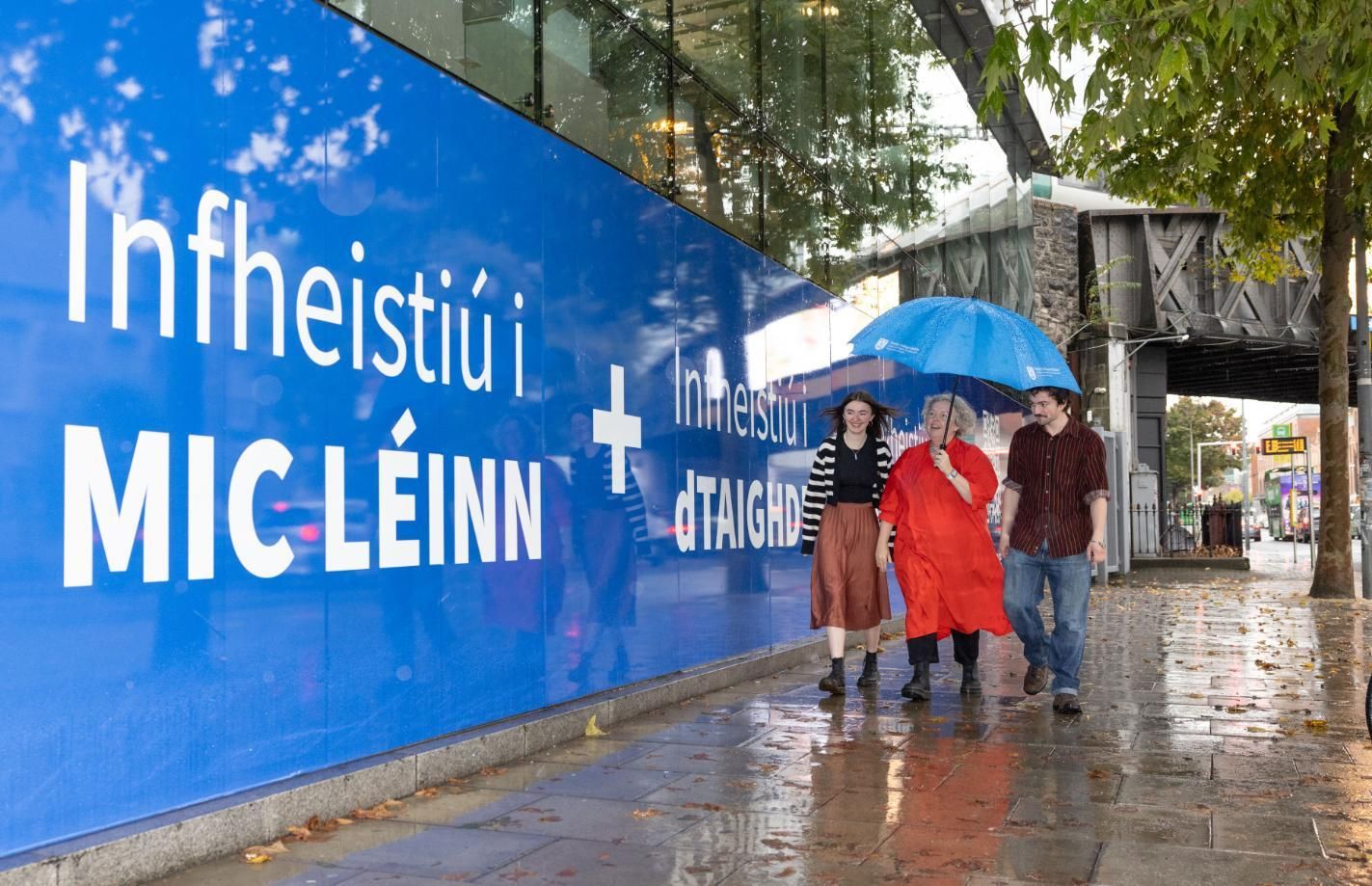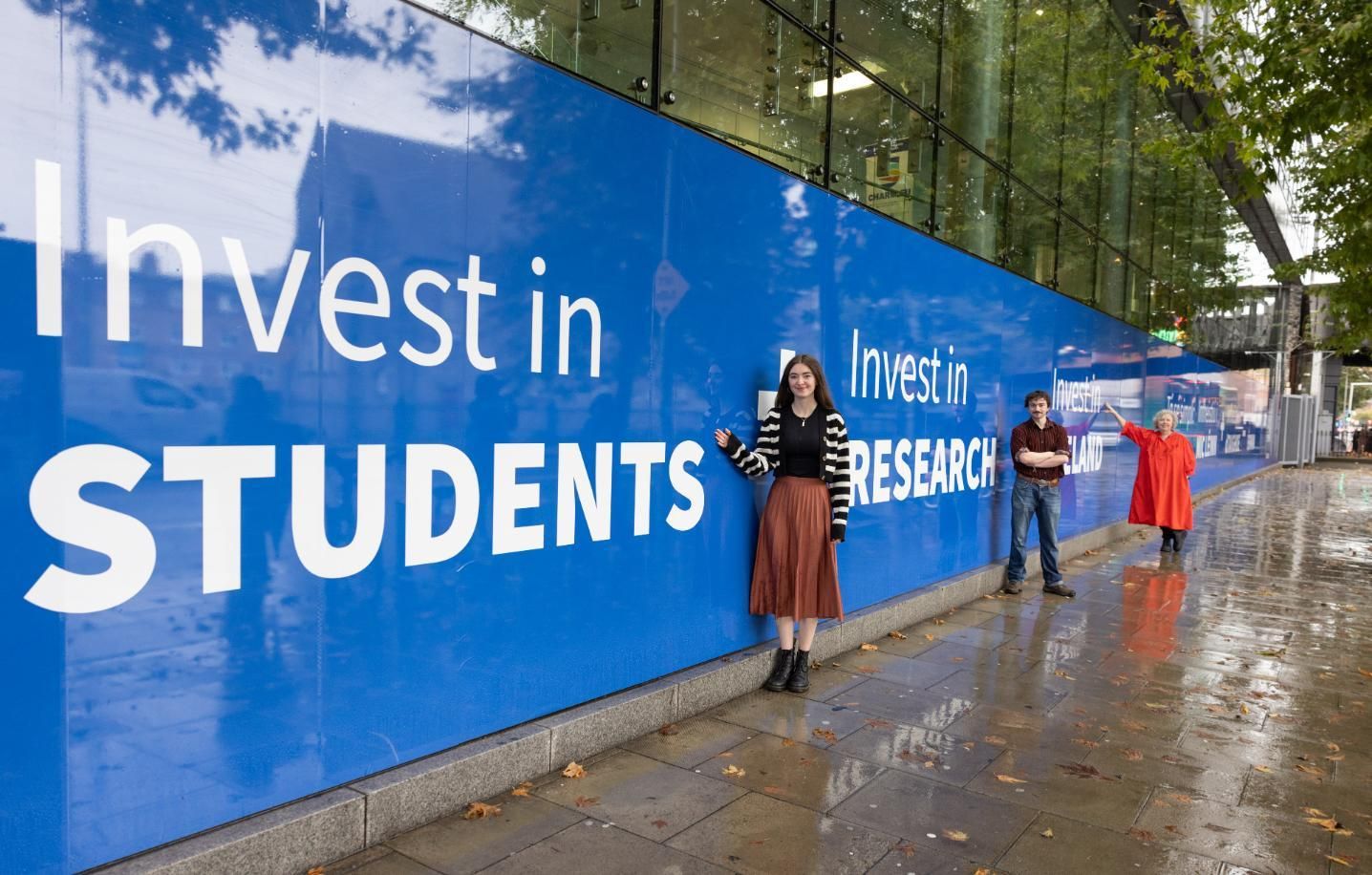Invest in students + invest in research = invest in Ireland
Posted on: 03 October 2025
/prod01/channel_3/media/tcd/news-images/Decal-main-855.jpeg)
Provost Linda Doyle, TCDSU-AMLCT* Education Officer Buster Whaley and Oifigeach na Gaeilge Aoife Ní Bhriain today (3 October 2025) sent a message to Government seeking increased funding for students and research in Tuesday's Budget.
*Trinity College Dublin Students' Union/Aontas Mac Léinn Choláiste na Tríonóide

Aoife Ní Bhriain, Provost Dr Linda Doyle and Buster Whaley outside the Naughton Institute on Dublin's Pearse Street
Recently, Chair of Trinity's Board, Paul Farrell, wrote in the Sunday Independent that strong research environment will boost Ireland’s global competitiveness, drive innovation and create the sustainable jobs we badly need.
Op ed: It's delusional to think universities will thrive without extra funding.
by Paul Farrell
“The value of an idea lies in the using of it,” said Thomas Edison, whose many credited inventions include the commercially viable light bulb. It remains as true today as it did a century ago.
It is a useful reminder that we can have as many ideas as we want, but unless they translate into real-world impacts, their value will be limited.
Thankfully, our Government shares this view. James Lawless, the Minister for Further and Higher Education, is on record as saying: “Ireland’s greatest strength lies in our people, and in the ideas and talents that they bring forward.” He has declared a plan to “advance a step change in research and innovation, strengthening our skills base and providing high-quality and accessible higher education”.
He clearly understands that universities are not only useful for producing highly skilled graduates, but also that a strong research environment will boost Ireland’s global competitiveness, drive innovation and create the sustainable jobs we badly need.
As welcome as this is, it remains to be seen how this commitment will translate into practical support for research-intensive institutions such as Trinity College Dublin, whose board I have chaired for the past two years.
In this period, I have formed the view that Ireland has begun to take for granted that its third-level institutions will thrive, despite years of underinvestment. This is delusional.
Universities are incredible places to be, with an extraordinary breadth of activity to be found around every corner. Trinity is home to brilliant researchers and lecturers and so many students with boundless curiosity. It has actively improved access for students with disabilities, and those with socioeconomic disadvantage.
However, the reality is that universities like Trinity are experiencing severe pressure on their research infrastructure.

As a businessperson, I am shocked by the level of financial insecurity faced by the third-level sector. The hidden cost of this insecurity is the amount of management and staff time taken up merely keeping the ship afloat, finding funding and negotiating the tricky waters of competitive research funding. This is time stolen from research and academic pursuits.
The real-world impact of Trinity’s research was recently demonstrated by the new €2m state-of-the-art wearable brain scanner, now up and running at Trinity College Institute of Neuroscience. The device, which can be worn by children, is helping researchers study the brain and identify the earliest signs of life-changing conditions such as epilepsy, dementia and ADHD. Trinity’s business engagement is also notable. In the past five years, 30 spin-out companies have been formed, creating 800 jobs and raising close to €350m in funding. That is not all; 288 invention disclosures have been completed; 88 patents have been filed; 124 licences have been agreed; and Trinity has engaged in 530 industry collaborations, 45pc of which have been with SMEs.
All this good news notwithstanding, it has also been chastening to see just how funding deficits have affected third-level education.
Over a third of university research equipment will be obsolete this year; by 2030, this figure will rise to 80pc. Some 60pc of research equipment is more than 10 years old; one-third is over 15 years old. This is not unique to Trinity. I have seen at close quarters how previously world-leading innovative education facilities around the country are being hamstrung by the lack of capital funding to replace obsolete equipment.
Amid the recent headlines over the Leaving Certificate and CAO offers, what has gone unreported is the fact that students who secure a university place are entering a sector plagued by stubbornly high student-staff ratios.
Irish universities average 21 students per faculty member, far higher than the EU average of 15.3 to one.
The Irish Universities Association, of which Trinity is a member, is calling on the Government to prioritise a set of policy measures in Budget 2026 to accelerate research investment and close historical funding gaps. This will include an overall investment package of €378m. I am fully behind this call.
Enhanced funding of higher education is not even a cost, by any normal measure. It is a strategic investment in economic prosperity and business innovation. Investing in students and investing in research simply equates to investment in Ireland.
By empowering universities through research funding, infrastructure support and collaboration incentives, we will cultivate a robust pipeline of talent, fuel breakthrough technologies, generate high-impact start-ups, and reap significant socioeconomic returns. Isn’t this what we all want?
For businesses to flourish in today’s knowledge-driven economy, universities must be sustained as dynamic partners and innovation engines.
I will leave the last word to Bill Gates, the founder of Microsoft: “I believe in innovation and that the way you get innovation is you fund research, and you learn the basic facts.”
It is hard to argue with that.
Media Contact:
Catherine O’Mahony | Media Relations | catherine.omahony@tcd.ie
